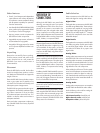
20
RSP-1069 Surround Sound Processor
Standard Definition
TV Monitor Outputs
The S-Video or Composite Video TV MONI-
TOR outputs of the RSP-1069 send the video
signal to a standard definition TV monitor.
These video outputs can only send a 480i/576i
standard definition video signal to a TV. They
can only output video signals from a standard
definition 480i/576i component. Signals
from progressive scan DVD players or other
high definition sources cannot be downcon-
verted to standard definition for S-Video or
Composite Video.
In most cases, S-Video outputs will provide bet
-
ter picture quality than Composite Video.
ZONE VIDEO Outputs
The ZONE VIDEO outputs of the RSP-1069
send a composite video signal to a TV moni
-
tor in Zone 2, Zone 3, or Zone 4.
NOTE: Only composite video input signals are
available at the ZONE VIDEO outputs.
Audio Inputs & Outputs
The RSP-1069 provides both analog and digi-
tal audio connections.
Digital Inputs
The RSP-1069 accepts digital inputs from
source components such as CD players, sat
-
ellite TV tuners, and DVD players. The built-
in digital processor senses the correct sam-
pling rates.
NOTE: With a digital input connection, the
RSP-1069 will be used to decode the signal,
rather than the source component’s internal
decoders. You must use digital connections
for a DVD player that supplies a Dolby Digital
or DTS signal; otherwise the RSP-1069 will
not be able to decode these formats.
There are seven digital inputs on the rear
panel, three coaxial and four optical, as
well as the HDMI Audio input that is carried
by the HDMI cables along with the digital
video signals. These digital inputs can be as
-
signed to any of the input sources using the
INPUT SETUP screen during the setup pro-
cess. For example, you can assign the CO
-
AXIAL 1 digital input connector to the VIDEO
1 source and the OPTICAL 2 digital input to
the VIDEO 3 source. By default, the source
input buttons are factory configured to select
the following inputs:
CD: Digital Coaxial 2
Tuner: Analog
Tape: Digital Coaxial 3
Video 1: HDMI Audio (HDMI 1)
Video 2: HDMI Audio (HDMI 2)
Video 3: Digital Optical 1
Video 4: Digital Optical 2
Video 5: Digital Coaxial 1
NOTE: When using digital connections, you
may also want to make the analog audio
input connections described previously. The
analog connection is necessary to record to
an analog recorder in some circumstances
or for ZONE 2–4 operation
Digital Outputs
The RSP-1069 has two digital outputs (one
coaxial and one optical) to send the digital
signal from any of the digital inputs to a dig-
ital recorder or outboard digital processor.
When a digital input source signal is selected
for listening, that signal is automatically sent
to both digital outputs for recording.
NOTE: Only digital signals from source com-
ponents are available at these outputs. Ana
-
log signals cannot be converted and are not
available at the digital outputs.
Tuner Inputs
A left/right pair of RCA analog audio inputs
for connecting an AM/FM tuner.
CD Inputs
A left/right pair of RCA analog audio inputs
for connecting a CD player.
TAPE Inputs
A pair of RCA inputs, labeled TAPE IN, for
connecting the left/right analog audio sig
-
nals from an audio tape deck or recording
device.
TAPE Outputs
A pair of RCA inputs, labeled TAPE OUT,
for sending left/right line level analog au
-
dio signals for recording on a tape deck or
recording device.
NOTE: These outputs should be connected to
the inputs of the same tape deck connected
to the TAPE IN inputs.
VIDEO 1–5 Audio Inputs
Five pairs of RCA inputs (VIDEO IN 1–5) pro-
vide connections for left/right analog audio
signals from five additional source compo-
nents. These inputs have corresponding vid
-
eo inputs and are used for VCRs, satellite TV
tuners, DVD players, etc. However, they may
also be used for additional audio only com
-
ponents, simply by omitting the correspond
-
ing video connections.
VIDEO 1–2 Audio Outputs
Two pairs of RCA jacks (VIDEO OUT 1–2)
provide connections for sending line level
left and right analog audio signals for re-
cording to a VCR.
These connections correspond to the VIDEO
IN 1–2 connections. Make sure that you are
consistent. If you hook up a particular VCR
to the VIDEO 1 inputs, hook up the VIDEO
1 outputs to the same VCR.
NOTE: There are no analog audio outputs for
VIDEO 3, 4, & 5. Therefore, in an elaborate
system, hook up all of the VCRs and recording
devices to VIDEO 1–2 and use VIDEO 3, 4
& 5 for playback only components.
NOTE: Video 1–2 can be used for audio-only
tape decks, simply omitting the correspond
-
ing video connections.


















